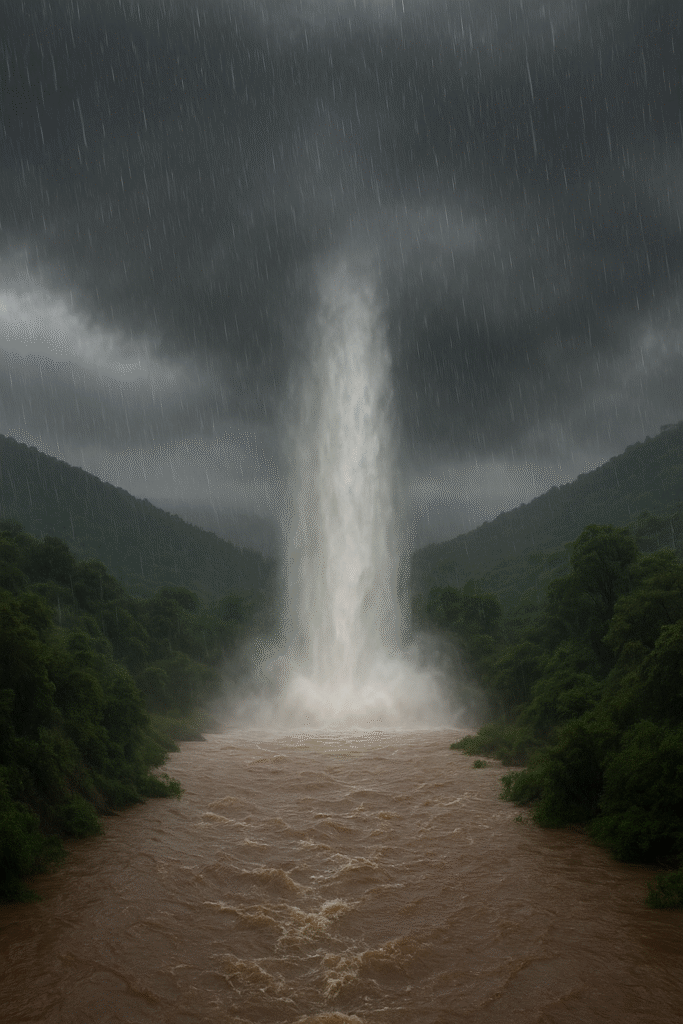🌧️ Pakistan Floods & Cloudbursts: Over 360 Lives Lost Amid Monsoon Havoc
Pakistan is reeling from devastating floods and cloudbursts that have killed more than 360 people in recent days. Entire villages in Khyber Pakhtunkhwa (KP) and Pakistan-administered Kashmir have been swept away as swollen rivers, mudslides, and collapsing homes left families buried under debris.

Floods in Buner: A District in Crisis
The Buner district of KP has been hit hardest, with more than 200 deaths reported in just two days. Steep mountains, erosion-prone soil, and deforestation have made Buner highly vulnerable to landslides and flash floods. Satellite images show towns like Pir Baba engulfed in mud and debris, while Urban Search and Rescue teams continue to recover bodies from collapsed homes.
What is a Cloudburst?
A cloudburst is a sudden and extreme rainfall event where more than 100mm of rain falls within an hour over a small area, typically in mountainous regions. In Buner, more than 150mm of rain fell in just one hour on August 17, 2025, triggering massive floods.
Key Factors Behind Cloudbursts:
- Geography: Common in mountainous areas like KP, Gilgit-Baltistan, Indian Occupied Kashmir, and the Himalayas.
- Moist Air Currents: Moist monsoon winds rising quickly over hills lead to rapid condensation.
- Deforestation & Soil Erosion: Reduce the land’s ability to absorb water, worsening flooding.
- Climate Change: Increasing frequency of extreme rainfall events worldwide, including South Asia.
Where Do Cloudbursts Happen the Most?
Cloudbursts mostly occur in northern Pakistan, India, Nepal, and the Himalayan belt, where mountains force moist air upwards. In Pakistan, regions like KP (Buner, Swat, Dir), Gilgit-Baltistan, and Azad Kashmir are highly prone to this phenomenon.
Human Impact & Rescue Operations
Survivors in Buner describe the terrifying experience:
“The thunder was so loud, it felt like the end of the world,” said Aziz Ahmed, a local schoolteacher.
Authorities have warned of further deluges and landslides as monsoon rains continue. Hundreds remain missing, while thousands have been displaced. Relief operations are ongoing, but accessibility to remote villages remains a major challenge.
Conclusion
The 2025 Pakistan floods and cloudbursts are a stark reminder of how vulnerable mountainous regions are to natural disasters. With climate change intensifying weather patterns, Pakistan must invest in better early warning systems, sustainable forest management, and climate-resilient infrastructure to protect communities from future tragedies.
❓ Frequently Asked Questions (FAQs)
1. What is a cloudburst in simple words?
A cloudburst is an intense rainfall where over 100mm of rain falls within an hour, usually in mountainous areas, leading to flash floods and landslides.
2. Why is Buner so vulnerable to floods?
Buner’s steep slopes, loose soil, and deforestation make it highly prone to flash floods and landslides during heavy rainfall.
3. Which areas of Pakistan are most at risk of cloudbursts?
Regions in Khyber Pakhtunkhwa, Gilgit-Baltistan, Swat, Dir, Azad Kashmir, and northern Punjab are highly vulnerable due to their mountainous terrain.
4. How does climate change affect floods in Pakistan?
Climate change is making monsoon rains more unpredictable and intense, increasing the risk of flash floods, cloudbursts, and landslides.
5. What can Pakistan do to reduce flood disasters?
- Develop early warning systems.
- Promote reforestation.
- Build climate-resilient infrastructure.
- Improve disaster management in high-risk areas.


